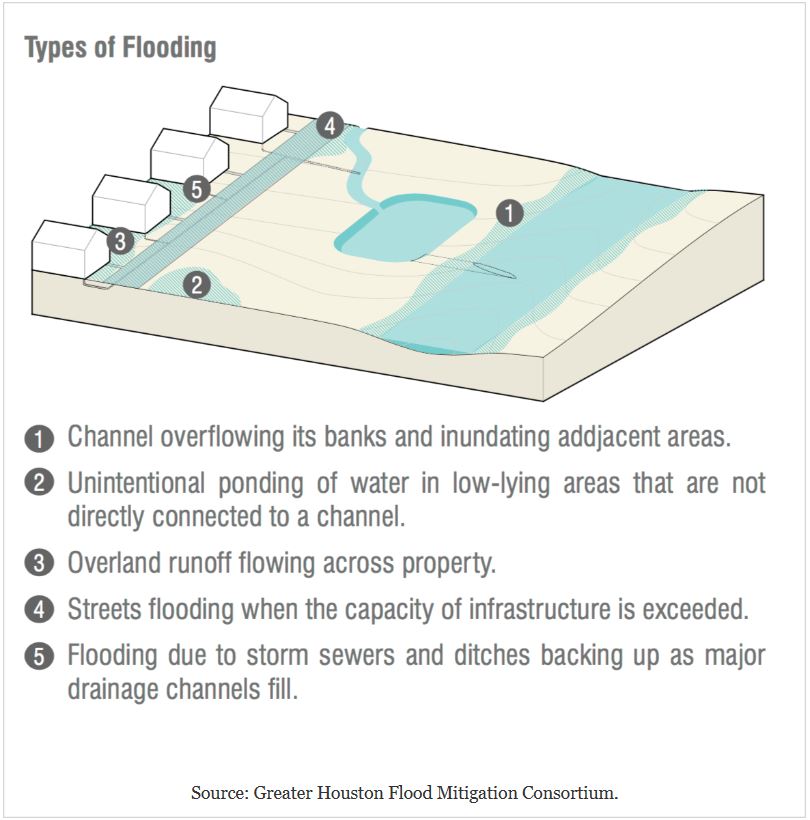Example - how to evaluate flood risk for potential property purchase
An article in the Houston Chronicle by Vanessa Brashier dated February 25, 2018 provides a case study for how a prospective property buyer could perform an initial evaluation of flooding risk. The article is entitled "Liberty County community signals growth is ahead - Encino Estates offers country living and affordability north of Dayton."
To begin the evaluation the prospective property buyer could easily perform two key steps from their home computer as follows:
Step 1: Locate property using Google Maps.
In this example I entered the search term "maps encino estates liberty county, tx" and then clicked on the Directions tab on the featured listing as shown below.
The resulting map is shown in Figure 1.
Encino Estates is a new development, so the actual area of the subdivision does not show up on the Streets map. However, switching the Google Map to satellite image and zooming in shows the new roads that have been constructed on the west side of FM 1008 (Figure 2).
This is important because the east side of FM 1008 is a marsh area in the Trinity River floodplain.
Step 2: Determine location of property relative to flood hazard areas.
There are multiple sources from which the Flood Insurance Rate Map (FIRM) can be viewed online. Often the county in which the property is located will have an interactive GIS map product showing flood zones. In this case the Liberty County maps are available at the link below:
Figure 3 is the Liberty County GIS viewer showing the flood zones around Encino Estates.
There are potential drawbacks to using this product as the user must properly select and understand the relevant layers. Also, there does not appear to be any documentation regarding the effective date of the FIRM being displayed or whether there are new (preliminary) maps available. Newer maps, even though not yet adapted for regulatory purposes, are often more accurate depictions of risk.
FEMA maintains an online risk map viewer that shows many Texas counties. The Liberty County version is available at the link below:
This product is preferred because it shows both Effective and Preliminary flood hazard zones and the FIRM panel documentation. It also has a Search by Address feature that is quite useful. Color-coded Change Layers indicate where Special Flood Hazard Areas (SFHA) are increasing or decreasing in size.
In this case the Preliminary FIRM shows an expansion of the SFHA along a creek that connects to the Trinity River floodplain (Figure 4).
This places a high-risk flood hazard area adjacent to the southwest corner of Encino Estates that was not present on the previous FIRM shown in Figure 5.
The Change Layers map is shown in Figure 6.
For this area the Preliminary FIRM is dated 9/30/2015. According to the Chronicle article the land being developed was originally purchased in 2003.
Additional steps that could potentially reveal more information regarding the flooding risk are:
1. Review topography around property in detail:
- Are there nearby low areas subject to water ponding?
- Are there areas at the same or lower depths than nearby floodplains but not mapped as flood hazard zones?
2. Review previous flooding damage to structures in the area:
- Are there nearby repetitive loss properties?
- Were structures built before regulations for construction in floodplains went into effect?
- If properties in the area have flooded previously, have there been drainage improvements or mitigation projects undertaken since then?
Information needed to answer these questions may not be readily available to the average property buyer.
In the case of Encino Estates, the Houston Chronicle article states that "the subdivision sits on a high ridge and did not go underwater during recent flooding." As a prospective buyer, is a statement like that enough for you? Are you satisfied that you can easily obtain the information you need to properly evaluate flooding risk?









Comments
Post a Comment